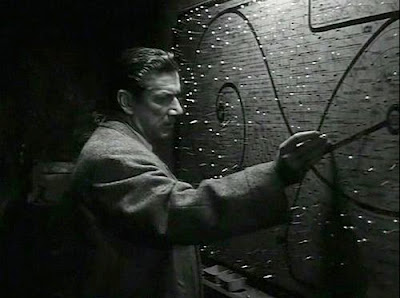July 20, 1958 [I Bury the Living]
 The big man at the center of I Bury the Living, Richard Boone, seemed at once familiar and out of place--I know I've seen him before--a Senator in The Robe?--no: Pilate himself--but I didn't quite buy it then, and still don't, not all the way, with his big frame and heavy features, more Raymond Burr than Monty Clift--or Victor Mature without a trace of vanity. In I Bury the Living he's a small-city department store executive--part of a group that takes turns managing the local cemetery--all of it odd, from Boone squeezed into a business suit to the giant map of the cemetery itself, dotted with little pins--white for the living owner, black when they die--and Boone starts to believe that, if he puts a black pin on the plot of someone still alive, they die--and he believes this because they do.
The big man at the center of I Bury the Living, Richard Boone, seemed at once familiar and out of place--I know I've seen him before--a Senator in The Robe?--no: Pilate himself--but I didn't quite buy it then, and still don't, not all the way, with his big frame and heavy features, more Raymond Burr than Monty Clift--or Victor Mature without a trace of vanity. In I Bury the Living he's a small-city department store executive--part of a group that takes turns managing the local cemetery--all of it odd, from Boone squeezed into a business suit to the giant map of the cemetery itself, dotted with little pins--white for the living owner, black when they die--and Boone starts to believe that, if he puts a black pin on the plot of someone still alive, they die--and he believes this because they do.It's a story as contrived as the TV shows I know I've seen Boone in; but the director forces it to work, thick expressionistic layers laid on like bricks. And he does a solid job of it, keeping us in the dingy room at the cemetery where the map hangs, large and pulsing, almost alive, the pins gigantic in closeup, spread out on a Salvador Dali plain--while the room itself shrinks, fills with fog and smoke and shadow, as though the 1920s had never left the screen.
And Boone handles himself well, wrestling some real panic out of his bulk, a big man undone by, as he put it, a strange feeling he has carried with him all his life, that he is reliving things--or making them happen. The resolution is at first more Hardy Boys than Jung, but the sense of a ghost-world lingers, as Boone, his overcoat lost, wanders off, speaking softly: "I think I can find it myself."
What's going on here? Why all these pictures filled with Forces--psychic, supernatural, science-fictional--that compel otherwise sturdy folk to shamble around like zombies? Is the American Dream just that, the constant New Model and backyard bar-b-que innovation things in our sleep? I like my charcoal grill and Dodge, and I'm glad for the March of Dimes that led right up to Jonas Salk's door; but these movies--and isn't it funny that most of them blare away at the drive-in, where the kids play and the teens go exploring--whisper that we don't have what we've assumed is ours, and that some price will need to be paid just to keep us dreaming.


Comments
Post a Comment